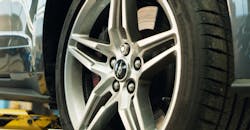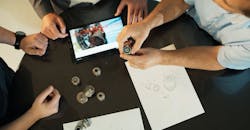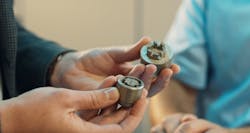Additive Manufacturing Gives Car Buyers a Voice
As alloy wheels and vehicle customization have grown in popularity, component theft has unfortunately become a lucrative side business. “It’s one of the worst experiences for a driver, to find their car up on blocks with all four wheels gone,” says Raphael Koch, research engineer, Advanced Materials and Processes, Ford of Europe.”Some alloy wheels can cost thousands to replace, but these unique rim nuts will stop thieves in their tracks. Making wheels more secure and offering more product personalization are further proof that 3D printing is a game-changer for car production.”
In collaboration with additive manufacturing solutions provider EOS and software developer Trinckle, engineers at Ford have now developed unique locking wheel nuts using 3D printing technology. “We thought about using fingerprinting, or an iris scan or something that could actually modify the groove or curve of the lug nut,” says Michael Jan Galba, Head of Global Consulting & Manufacturing Engineering at EOS. “Trinckle proposed adapting an application they used in a completely different industry that utilized a voice wave curve.”
With the geometry in place, the nut and key are designed as one piece, then 3D-printed using acid and corrosion resistant stainless steel. When finished, the nut and key are separated, with a small amount of grinding required to make them ready for use.
The design also includes second level security features that prevent the nut from being cloned or copied. The unevenly spaced ribs inside the nut and indentations that widen the deeper they go prevent a thief from making a wax imprint of the pattern, as the wax breaks when it is pulled from the nut.
If not using the driver’s voice to create the contours, the nuts could feature designs specific to a vehicle, such as with the Mustang logo, or use the driver’s initials. The design could also take inspiration from a driver’s interest, for example, by using the outline of a famous racetrack.
“Cross industry brainstorming with EOS and Trinckle allowed us to come up with a simple, yet effective idea of using the wave curve to create a pattern that is really unique for each and every customer,” Bognar tells IndustryWeek. “Fortunately, when it comes to customization, we have only scratched the surface of what is actually possible.”
Additive manufacturing offers design flexibility to help reduce weight, improve performance and create parts that wouldn’t be possible using conventional methods. For more than 30 years, Ford has increasingly used 3D printing to make prototype parts which help reduce the development time for new vehicles.
The company has also used this technology to create parts that feature in the Ford GT, Focus and Mustang GT500, and will make more 3D-printed parts in the future. Special bespoke car parts are also 3D printed, including the intake manifold in Ken Block’s Hoonitruck and the pair of wind louvres found on the M-Sport Ford Fiesta World Rally Championship car.
Ford has also used 3D printing to create assembly line tools that are up to 50 percent lighter, which makes repetitive tasks less physically stressful and helps improve manufacturing quality. As many of these tools are made of nylon, Ford has introduced a recycling program that turns old 3D-printed pieces and plastics from manufacturing areas into 100 percent recycled nylon. Ford also creates 3D-printed safety equipment, such as protection sleeves for rotating tools used on the production line, which prevent operators from incurring finger and arm injuries.
About the Author
Peter Fretty
Technology Editor
As a highly experienced journalist, Peter Fretty regularly covers advances in manufacturing, information technology, and software. He has written thousands of feature articles, cover stories, and white papers for an assortment of trade journals, business publications, and consumer magazines.



